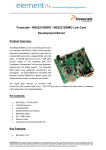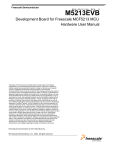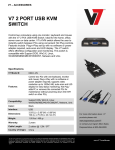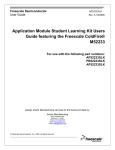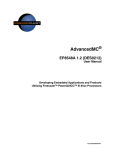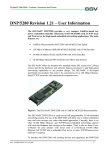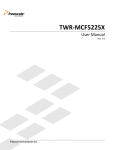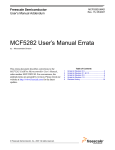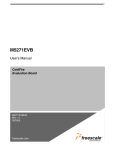Download M5211DEMO
Transcript
Freescale Semiconductor Document Number: M5211DEMO Rev. 1, 04/2007 Demonstration Board for Freescale MCF5211 1 Overview The M5211DEMO is a low-cost development system for the Freescale MCF5211 ColdFire® microcontroller. Application development is quick and easy with the included DB9 serial cable and integrated BDM. The integrated BDM is compatible with popular hosting software and allows easy application development and debugging. An optional BDM port compatible with standard ColdFire BDM / JTAG interface cables and hosting software is provided but not installed. © Freescale Semiconductor, Inc., 2007. All rights reserved. Contents 1 2 3 4 5 6 7 8 9 10 11 12 13 Overview . . . . . . . . . . . . . . . . . . . . . . . . . . . . . . . . . . . . . 1 Getting Started . . . . . . . . . . . . . . . . . . . . . . . . . . . . . . . . 5 Software Development . . . . . . . . . . . . . . . . . . . . . . . . . . 5 Operating Modes . . . . . . . . . . . . . . . . . . . . . . . . . . . . . . . 5 Memory Map . . . . . . . . . . . . . . . . . . . . . . . . . . . . . . . . . . 6 Development Support . . . . . . . . . . . . . . . . . . . . . . . . . . . 7 Power . . . . . . . . . . . . . . . . . . . . . . . . . . . . . . . . . . . . . . . 8 Reset . . . . . . . . . . . . . . . . . . . . . . . . . . . . . . . . . . . . . . . 11 Low-Power Modes. . . . . . . . . . . . . . . . . . . . . . . . . . . . . 12 Timing . . . . . . . . . . . . . . . . . . . . . . . . . . . . . . . . . . . . . . 12 Communications . . . . . . . . . . . . . . . . . . . . . . . . . . . . . . 13 User Options . . . . . . . . . . . . . . . . . . . . . . . . . . . . . . . . . 14 I/O Port Connector. . . . . . . . . . . . . . . . . . . . . . . . . . . . . 16 Overview Figure 1. M5211DEMO Board 1.1 • • • • Features MCF5211 CPU, 64 pins — 128 byte flash — 16K byte RAM — 2K byte cache RAM — DMA controller with timers — Interrupt controller — Eight channel 12 bit A/D — QSPI, IIC, and CAN serial ports — 1 x UART Serial Ports with DMA capability — Edge / interrupt port — Eight PWM timers — Four GPT timers — BDM / JTAG port — 3.3 V operation — 66 MHz bus 40 pin I/O port Integrated USB BDM port BDM / JTAG port, 26 pins, development port (not installed) Demonstration Board for Freescale MCF5211, Rev. 1 2 Freescale Semiconductor Overview • • • • • • • • • • 1.2 • • • RS-232 serial port with DB9-S connector Timing options — Internal oscillator, 8 MHz — External XTAL option (not installed) — External clock options (not installed) RESET switch with indicator ON/OFF Power Switch w/ LED indicator Power input selection jumper — Power input from USB BDM — Power input from on-board, +3.3 V, regulator — Power input from terminal block — Power from connector J1 — Optional power output through connector J1 User features — Four user LEDs with enable jumper — Two user push switches — 5 kΩ POT with enable jumper Option jumpers — Power input select — Optional power output Enable — BDM_EN — XTAL_EN — POT_EN — COM_EN — LED_EN Connectors — DB9 serial connector — Type B USB connector — 2.0 mm barrel power input — 2 pos, screw type, terminal block Supplied with DB9 serial cable, USB cable, utility / support CD Manuals and wall adapter power supply. Specifications Board size: 3.5" x 5.5" Power input: +5 to +20 VDC, 9 VDC typical Current consumption: 100 mA typical at 9 VDC input Demonstration Board for Freescale MCF5211, Rev. 1 Freescale Semiconductor 3 Overview 1.3 Reference Documents Table 1 shows a list of reference documents that are provided on the support CD in Adobe Portable Document Format (PDF). Table 1. Reference Documents File name 1.4 Document Description M5211DEEMO_UG.pdf M5211DEMO User Guide (this document) M5211DEMO_SCH_E.pdf M5211DEMO Schematic, Rev E M5211DEMO_QSG.pdf M5211DEMO Quick Start Guide M5211DEMO_example1.zip CodeWarrior Demo Application M5211DEMO_example2.zip CodeWarrior Demo Application MCF5213RM.pdf MCF5213 Reference Manual MCF5213DE.pdf MCF5213 Device Errata Cautionary Notes Electrostatic discharge (ESD) prevention measures must be used when handling this product. ESD damage is not a warranty repair item. The manufacturer of this board, Axiom Manufacturing, does not assume any liability arising out of the application or use of any product or circuit described herein; neither does it convey any license under patent rights or the rights of others. 1.4.1 EMC Information on the M5211DEMO board This product is shipped from the factory with associated power supplies and cables, and has been verified to meet with requirements FCC as a CLASS A product. This product is designed and intended for use as a development platform for hardware or software in an educational or professional laboratory. In a domestic environment, this product may cause radio interference in which case you may be required to take adequate prevention measures. Attaching additional wiring to this product or modifying the product operation from the factory default as shipped may effect its performance and cause interference with other apparatus in the immediate vicinity. If such interference is detected, suitable mitigating measures must be taken. 1.5 Terminology This development board uses option selection jumpers. A jumper is a plastic shunt that connects two terminals electrically. Terminology for application of the option jumpers is as follows: • Jumper on, in, or installed—jumper is installed such that two pins are connected. • Jumper off, out, or idle— jumper is installed on one pin only. It is recommended that jumpers be idled by installing on 1 pin so they will not be lost. Demonstration Board for Freescale MCF5211, Rev. 1 4 Freescale Semiconductor Getting Started 2 Getting Started To get started, please refer to the M5211 Quick Start Guide included with this development kit. The M5211DEMO single board computer is a fully assembled, fully functional development board for the Freescale MCF5211 microcontroller. An included serial cable, USB cable, and support software allows you to get started quickly. The purpose of this development board is to assist you in quickly developing an application in a known working environment, to provide an evaluation platform, or as a control module for an embedded system. You should be familiar with memory mapping, memory types, and embedded software design for successful application development. You should be familiar with the hardware and software operation of the target MCF5211 device before beginning. If necessary, refer to the MCF5213 Integrated Microcontroller Reference Manual, included on the support CD, for details on the operation of the MCF5211. 3 Software Development Software development requires the use of a ColdFire assembler or compiler and a host PC running a ColdFire BDM interface. CodeWarrior 6.1 Special Edition, which is supplied with this board, allows you to develop and debug application code and to program the flash memory. To ensure successful application development, load and execute the application from RAM. After the application has been completely debugged fully functional, it can be ported to flash memory. When programmed into flash memory, the application will execute from power-on or RESET. 4 Operating Modes The M5211DEMO board operates in two basic modes RUN mode, or DEBUG mode. RUN mode executes user application code from power-on or reset. DEBUG mode supports the development and debug of applications via the integrated USB BDM. An optional BDM_PORT is provided but not installed. See the related sections below for quickly starting the board in the desired mode of operation. The board has been preloaded with a demonstration program that operates in the RUN mode (see the M5211DEMO Quick Start Guide for additional information). The VDD LED is lit when power is applied to the board and the PWR_SEL option header is set correctly. The OFF/ON switch must also be set to the ON position. 4.1 RUN Mode RUN mode allows your application to execute out of flash memory when power is applied to the board or the RESET button is pressed. Use these settings to configure the M5211DEMO board for RUN mode using the USB bus to power the board. See tSection 7, “Power,” for details on configuring the board for alternate power input. 1. Connect a serial cable between the board and a host PC if needed. 2. Connect auxiliary equipment to board if needed. 3. Configure the board option jumpers as shown in Table 2. Demonstration Board for Freescale MCF5211, Rev. 1 Freescale Semiconductor 5 Memory Map Table 2. Run Mode Setup PWR_SEL Set to VB BDM_EN OFF COM_EN ALL ON (if required) VX_EN ON (if required) Connect the USB cable to an open USB port on the host PC and attach to the USB port on the target board. LED's 1–4 located adjacent to the DB-9 connector, and the VDD LED will light and the loaded application will begin to execute. 4.2 DEBUG Mode DEBUG mode supports application development and debug using the ColdFire background debug mode (BDM). Background mode is accessible using either the integrated USB-BDM or an external ColdFire BDM cable. Use of the integrated BDM requires a host PC with an available USB port and an A/B USB cable and appropriate hosting software. The USB cable used must be USB 2.0 compliant. A 26-pin BDM_PORT header supports the use of an external BDM cable. This header is not installed in default configurations. The steps describe using the integrated USB-BDM. See Section 7, “Power,” for details on configuring the board for alternate power input. 1. Connect a serial cable between the board and a host PC if needed. 2. Connect auxiliary equipment to board if needed. 3. Install and launch CodeWarrior™ 6.1 Special Edition, or other software capable of communicating with the ColdFire MCU. 4. Configure the board option jumpers as shown in Table 3. Table 3. Debug Mode Setup PWR_SEL Set to VB BDM_EN ON COM_EN ALL ON (if required) VX_EN ON (if required) Connect the supplied USB cable between an available USB port on the host PC and the USB connector on the board. Hosting development software will establish background communication. 5 Memory Map Refer to the MCF5213 Integrated Microcontroller Reference Manual for details. Demonstration Board for Freescale MCF5211, Rev. 1 6 Freescale Semiconductor Development Support 6 Development Support Application development and debug for the target MCF5211 is supported through the BDM interface. The debug interface consists of an integrated USB-BDM debugger and an optional 26-pin header (BDM_PORT). The BDM_PORT header is not installed in default configuration, but you may install it if needed. 6.1 Integrated BDM_PORT The M5211DEMO board features an integrated USB-BDM debugger from P&E Microcomputer Systems. The integrated debugger supports application development and debugging via the background debug mode. A USB, type B, connector provides connectivity between the target board to the host PC. The integrated debugger provides power and ground to the target, thereby eliminating the need to power the board externally. When used, power from the USB-BDM circuit is derived from the USB bus and total current consumption is limited by the USB specification. Total current consumption for the target board, and all connected circuitry, must not exceed 500 mA. Excessive current drain will violate the USB specification causing the bus to disconnect. This forces a target POR. CAUTION Violating the USB specification will cause the USB bus to disconnect forcing the target to reset. Use of the integrated USB BDM requires the use of CodeWarrior 6.1 Special Edition or development tools from P&E Microcomputer Systems. 6.2 BDM_PORT Header A ColdFire BDM cable may be attached to the 26-pin BDM_PORT port header. This header is not installed in default configuration and its use requires you to install a 2x13, 0.1" center, BERG header. Refer to the BDM documentation in the MCF5213 User's Manual for details on the use of the BDM cable. The BDM_PORT header pin-out is shown in Figure 2. Demonstration Board for Freescale MCF5211, Rev. 1 Freescale Semiconductor 7 Power NC 1 2 BKPT* GND 3 4 DSCLK GND 5 6 TCLK (JTAG) RSTI* 7 8 DSI VDD 9 10 DSO GND 11 12 ALLPST ALLPST 13 14 ALLPST ALLPST 15 16 NC NC 17 18 NC NC 19 20 GND NC 21 22 NC GND 23 24 TCLK (BDM) VDD 25 26 TA* See the ColdFire BDM chapter in the MCF5213 User's Manual for complete BDM_PORT documentation. Note: This header is not installed in default configuration. Figure 2. BDM_PORT Header 7 Power The M5211DEMO is designed to be powered from the USB_BDM during application development. A 2.0 mm barrel connector and a two-position, screw-type, terminal block (BATT) has been applied to support stand-alone operation. Additionally, the board may be powered through connector J1. The board may also be configured to supply power through connector J1 to external circuitry. An OFF/ON switch allows you to quickly and easily turn the board on and off. When using the integrated USB-BDM, the board draws power from the USB bus. Excessive current drain will violate the USB specification causing the USB bus to disconnect forcing a POR. Total current consumption of the board and connected circuitry, therefore, must be limited to less than 500 mA. CAUTION Violating the USB specification will cause the USB bus to disconnect. This will force a hard reset on the target. The installed barrel connector accepts a center-positive, 2.1 mm barrel plug. The terminal block accepts wire sizes ranging from 28 ga to 16 ga. Voltage input must be in the range between +5 V and +20 V. At no time should input voltage exceed +20 V as damage to the board may result. The terminal block input is connected directly to the upper voltage rail. Input protection is not applied on this voltage input. Exercise caution when using the terminal block to input power to the board. Voltage supplied through connector J1 is also connected directly to the board voltage rails. No protection is applied on this input and you must exercise caution when powering the board from connector J1. CAUTION Input protection is not applied to the J1 or BATT power inputs. Excessive input voltage or current will damage the board. Demonstration Board for Freescale MCF5211, Rev. 1 8 Freescale Semiconductor Power 7.1 7.1.1 Power Input Power (PWR) Jack The PWR power jack, shown in Figure 3, consists of a 2.1 mm, center-positive, barrel connector. Voltage applied at this connector should range between +5 V and +20 V. 2.0 mm–2.1 mm, center-positive, +V input Applied voltage: +5 V – +20 V PWR Figure 3. PWR Jack 7.1.2 Terminal (BATT) Block The BATT terminal block, shown in Figure 4, is a 3.5 mm, screw-type terminal block connected directly to the VDD voltage rail. Caution must be used when using this input since input protection is not applied. Use of this input requires a regulated +3.3 V voltage source. Accepts wire size 28 AWG – 16 AWG Applied voltage must be +3.3 V. + BATT - Figure 4. BATT Terminal Block 7.1.3 Connector J1 See the schematic for details on using this connection to supply power to the board or source power from the board. Use of this input requires a regulated +3.3 V voltage source. CAUTION Do not overdrive the J1 or BATT inputs as damage to the board may result. 7.2 VDD LED The VDD LED indicates the state of power applied to the development board. This LED is on when power is applied to the board. If no power is applied or the OFF/ON switch is in the OFF position, this LED be off. The VDD LED is located after the OFF/ON switch and will indicate the state of the switch if the board is powered from the on-board regulator, the USB circuit, or the BATT terminal block input. Demonstration Board for Freescale MCF5211, Rev. 1 Freescale Semiconductor 9 Power 7.3 Power (OFF/ON) Switch The OFF/ON switch, shown in Figure 5, connects and disconnects all input voltage sources to the board. In the OFF position, the board is unpowered and no voltage is present on the upper voltage rail. In the ON position, the input voltage source is connected to the upper voltage rail. OFF/ON CONFIGURATION OFF—Input power source disconnected from upper voltage rail OFF/ON ON—Input power source connected to upper voltage rail Figure 5. OFF/ON Switch 7.4 Power Select Configuration of applied input power is controlled using two option headers. The PWR_SEL header selects between the on-board voltage regulator and the USB voltage input. The VX_EN header connects J1-1 directly to the upper voltage rail. The illustrations below show the different configuration for each option header. 7.4.1 PWR_SEL Figure 6 shows the PWR_SEL header. Select power input from USB-BDM VB VDD PWR_SEL Select power input from VR1 VB VDD PWR_SEL Figure 6. PWR_SEL Option Header Power from the integrated BDM is drawn from the USB bus and is limited to 500 mA. Excessive current drain will violate the USB specification causing the USB bus to disconnect. CAUTION Violating the USB specification will cause the USB bus to disconnect. This will cause the board to reset. The on-board voltage regulator (VR1) accepts power input through a 2.1 mm barrel connector (PWR). Input voltage may range from +5 V to +20 V. VR1 provides a +3.3 V fixed output limited to 800 mA. Over-temperature and over-current limit built into the voltage regulator provides limited protection from damage due to excessive stresses. Demonstration Board for Freescale MCF5211, Rev. 1 10 Freescale Semiconductor Reset Consider the maximum output current of the selected power source when attempting to power off-board circuitry through connector J1. 7.4.2 VX_EN The VX_EN option header is a two-pin jumper that connects the target-board voltage rail to J1-1. J1-3 is connected directly to the ground plane. Use of this input requires a regulated +3.3 V voltage source. This power input is decoupled to minimize noise input but is not regulated. Also, no protection is applied on this input and damage to the target board may result if over-driven. Do not attempt to power the target board through this connector while applying power through the USB-BDM or the PWR connector; damage to the board may result. Power may be sourced to off-board circuitry through the J1 connector. The current limitation of the USB bus or the on-board regulator must be considered when attempting to source power to external circuitry. Excessive current drain may damage the target board, the host PC USB hub, or the on-board regulator. Figure 7 details the VX_EN option header connections. ON Enable power connection to connector J1 OFF Disable power connection to connector J1 VX_EN VX_EN Figure 7. VX_EN Option Header CAUTION Do not apply power to connector J1 while sourcing power from either the PWR connector or the USB-BDM circuit. Damage to the board may result. NOTE Do not exceed available current supply from USB-BDM cable or on-board regulator when sourcing power through connector J1 to external circuitry. 8 Reset The MCF5211 can be reset several ways. A RESET switch applies an external reset to the device. An internal low-voltage detect forces the part into RESET when voltage falls too low. The part may also be reset by applying a logic low on the RSTI* signal. The RSTI* signal is used by a connected BDM to force the part into reset when necessary. A reset indicator shows when the part is in reset. 8.1 Reset Switch The RESET switch provides a method to apply an asynchronous reset to the MCU and is connected directly to the RSTI* input on the MCU. Pressing the RESET switch forces the MCU into reset until the Demonstration Board for Freescale MCF5211, Rev. 1 Freescale Semiconductor 11 Low-Power Modes switch is released. An external pullup on the RSTI* line prevents spurious resets and allowing normal operation. 8.2 Low-Voltage Detect The MCF5211 utilizes an internal Low-Voltage Detect (LVD) to protect against under-voltage conditions. The LVD is enabled out of RESET. Consult the MCF5213 Integrated Microcontroller Reference Manual for details on configuring LVD operation. 8.3 Reset Indicator The RESET LED turns on when the MCU is in RESET and remains on for the duration of a valid RSTO* signal. 9 Low-Power Modes The MCF5211 supports several operational modes designed to reduce power consumption. Low-power modes include Wait, Doze, Stop, and Halt. Refer to the MCF5213 Microcontroller Family Hardware Specification and the MCF5213 Integrated Microcontroller Reference Manual for details on configuring and using the various low-power modes. 10 Timing Timing for the M5211DEMO is provided by an on-chip, 8 MHz relaxation oscillator in default configuration. Resistor R23 causes the MCU to select the internal oscillator as the timing source out of reset. Refer to the M5213 Integrated Microcontroller Reference Manual for details on use and configuration of internal timing. Pad locations for an external crystal oscillator have been provided but not populated in default configurations. The external oscillator is connected to the XTAL and EXTAL inputs. To implement an external crystal oscillator simply remove R23, install the oscillator and related circuitry. The XTAL_EN shunt must be installed to enable external timing operation. ON Enables external crystal oscillator input to MCU OFF Disables external crystal oscillator input to MCU XTAL_EN XTAL_EN Figure 8. OSC_EN Option Header Pad locations for an optional 32.768 kHz have also been provided but not populated. The 32.768 kHz timing input is connected to GPT0 and GPT1 inputs. To implement this timing input, simply install the timing source and related circuitry. Demonstration Board for Freescale MCF5211, Rev. 1 12 Freescale Semiconductor Communications 11 Communications The M5211DEMO board provides two Serial Communications Interface (SCI) ports, one Serial Peripheral Interface (SPI) port, and one Inter-Integrated Controller (IIC) port. RS-232 communications are supported through a DB9 connector and connector J1. SPI and IIC communications are supported through connector J1. The COM_EN option header enables SCI0 operation on the board. 11.1 SCI Port An RS-232 transceiver provides RS-232 to TTL/CMOS logic-level translation between the COM connector and the MCU. The COM connector is a 9-pin Dsub, right-angle connector. A ferrite bead on shield ground provides conducted immunity protection. Communication signals TXD0 and RXD0 are routed from the transceiver to the MCU. These signals are also available on connector J1. Hardware flow control signals RTS0 and CTS0are also routed from the transceiver to the MCU. Serial communications signals RXD1, TXD1, RTS1, and CTS1 are available on connector J1 and route directly between the MCU and connector J1. The SCI1 port does not have a RS-232 logic-level translation. 11.2 COM_EN The COM_EN option header (Figure 9) individually connects and disconnects SCI0 signals between the MCU and the SCI transceiver. Removing a shunt disconnects the associated signal. Installing a shunt connects the associated signal. Shunt COM_EN On Off CTS Enabled Disabled RTS Enabled Disabled RXD Enabled Disabled TXD Enabled Disabled Figure 9. COM_EN Option Header 11.2.1 COM Connector A standard 9-pin Dsub connector provides external connections for the SCI0 port. The Dsub shell is connected to board ground through a ferrite bead. The ferrite bead provides noise isolation on the RS-232 connection. The DB9 connector pinout is shown in Figure 10. Demonstration Board for Freescale MCF5211, Rev. 1 Freescale Semiconductor 13 User Options 4, 6 1 TXD 2 RXD 3 1, 6 4 GND 5 6 1, 4 Female DB9 connector that interfaces to the ColdFire internal SCI1 serial port via the RS232 transceiver. 7 RTS Pins 1, 4, and 6 are connected together. 8 CTS 9 NC Figure 10. COM Connector 11.3 SPI Port SPI signaling connects directly between connector J1 and the MCU. Refer to the MCF5213 Integrated Microcontroller Reference Manual for details on using the SPI interface. 11.4 IIC Port IIC signaling connects directly between connector J1 and the MCU. Refer to the MCF5213 Integrated Microcontroller Reference Manual for details on using the IIC interface. 12 User Options The M5211DEMO includes various input and output devices to aid application development. User I/O devices include two momentary pushbutton switches, four green LEDs, and one potentiometer. 12.1 Pushbutton Switches Two pushbutton switches provide momentary, active-low input, for user applications. Pull-ups internal to the MCU must be enabled to provide error free switch operation. Pushbutton switches SW1 and SW2 are connected to MCU I/O ports IRQ4* and IRQ7* respectively. 12.2 LED Indicators Indicators LED1 through LED4 are enabled by the LED_EN option header, shown in Figure 11. Each LED is active-high and illuminates when a logic high signal is driven from the respective MCU I/O port. A 3S buffer between the MCU port and the user LEDs provides the drive current necessary to control the LEDs. LED_EN ON User LEDs enabled active-high OFF User LEDs disabled LED_EN Figure 11. LED_EN Option Header Demonstration Board for Freescale MCF5211, Rev. 1 14 Freescale Semiconductor User Options A SW2_LED pad has been provided but not installed. If installed, this LED will light on SW2 press and will remain lit for approximately 2 ms after SW2 release. 12.3 Potentiometer A 5 kΩ, thumb-wheel type, potentiometer at RV1 provides continuous, variable resistance input for user applications. The output is the result of a voltage divider that changes as the thumb-wheel is turned. The potentiometer is connected between VDD and GND with the center tap providing the divider output. This center tap is connected to the MCU on signal AN0. The potentiometer may be disconnected from AN0 by means of the POT_EN option header, shown in Figure 12. ON User POT enabled OFF User POT disabled POT_EN POT_EN Figure 12. POT_EN Option Header 12.4 User Option Connection Summary Table 4 summarizes user option connections on the development board. Table 4. User Option Connections Option MCU Port MCU Pin SW1 IRQ4 57 SW2 IRQ7 58 LED1 DTIN0 22 LED2 DTIN1 23 LED3 DTIN2 18 LED4 DTIN3 19 RV1 AN0 25 Demonstration Board for Freescale MCF5211, Rev. 1 Freescale Semiconductor 15 I/O Port Connector 13 I/O Port Connector Connector J1 provides access to M5211DEMO I/O signals. Signal positions not shown are not connected (NC). VDD 1 2 IRQ1* GND 3 4 RSTI* UTXD1 5 6 RSTO* URXD1 7 8 URTS1* 9 10 ANO UCTS1* 11 12 AN1 GPT0 13 14 AN2 GPT1 15 16 AN3 QSPI_DOUT 17 18 AN4 QSPI_DIN 19 20 AN5 QSPI_SCLK 21 22 AN6 QSPI_CS0 23 24 AN7 UTXD0 25 26 SCL TRXD0 27 28 SDA URTS0* 29 30 GPT2 UCTS0* 31 32 GPT3 IRQ4* 33 34 DTIN0 VRH 35 36 DTIN1 VRL 37 38 DTIN2 IRQ7* 39 40 DTIN3 Figure 13. Connector J1 Table 5. Revision History Revision (Date) Description A (01/2006) Initial release as Axiom Manufacturing document. 1 (04/2007) • Converted document to Freescale identity and standards. • Formatting, layout, spelling, and grammar corrections. Demonstration Board for Freescale MCF5211, Rev. 1 16 Freescale Semiconductor THIS PAGE IS INTENTIONALLY BLANK Demonstration Board for Freescale MCF5211, Rev. 1 Freescale Semiconductor 17 How to Reach Us: Home Page: www.freescale.com Web Support: http://www.freescale.com/support USA/Europe or Locations Not Listed: Freescale Semiconductor, Inc. Technical Information Center, EL516 2100 East Elliot Road Tempe, Arizona 85284 +1-800-521-6274 or +1-480-768-2130 www.freescale.com/support Europe, Middle East, and Africa: Freescale Halbleiter Deutschland GmbH Technical Information Center Schatzbogen 7 81829 Muenchen, Germany +44 1296 380 456 (English) +46 8 52200080 (English) +49 89 92103 559 (German) +33 1 69 35 48 48 (French) www.freescale.com/support Japan: Freescale Semiconductor Japan Ltd. Headquarters ARCO Tower 15F 1-8-1, Shimo-Meguro, Meguro-ku, Tokyo 153-0064 Japan 0120 191014 or +81 3 5437 9125 [email protected] Asia/Pacific: Freescale Semiconductor Hong Kong Ltd. Technical Information Center 2 Dai King Street Tai Po Industrial Estate Tai Po, N.T., Hong Kong +800 2666 8080 [email protected] For Literature Requests Only: Freescale Semiconductor Literature Distribution Center P.O. Box 5405 Denver, Colorado 80217 1-800-441-2447 or 303-675-2140 Fax: 303-675-2150 [email protected] Document Number: M5211DEMO Rev. 1 04/2007 Information in this document is provided solely to enable system and software implementers to use Freescale Semiconductor products. There are no express or implied copyright licenses granted hereunder to design or fabricate any integrated circuits or integrated circuits based on the information in this document. Freescale Semiconductor reserves the right to make changes without further notice to any products herein. Freescale Semiconductor makes no warranty, representation or guarantee regarding the suitability of its products for any particular purpose, nor does Freescale Semiconductor assume any liability arising out of the application or use of any product or circuit, and specifically disclaims any and all liability, including without limitation consequential or incidental damages. “Typical” parameters that may be provided in Freescale Semiconductor data sheets and/or specifications can and do vary in different applications and actual performance may vary over time. All operating parameters, including “Typicals”, must be validated for each customer application by customer’s technical experts. Freescale Semiconductor does not convey any license under its patent rights nor the rights of others. Freescale Semiconductor products are not designed, intended, or authorized for use as components in systems intended for surgical implant into the body, or other applications intended to support or sustain life, or for any other application in which the failure of the Freescale Semiconductor product could create a situation where personal injury or death may occur. Should Buyer purchase or use Freescale Semiconductor products for any such unintended or unauthorized application, Buyer shall indemnify and hold Freescale Semiconductor and its officers, employees, subsidiaries, affiliates, and distributors harmless against all claims, costs, damages, and expenses, and reasonable attorney fees arising out of, directly or indirectly, any claim of personal injury or death associated with such unintended or unauthorized use, even if such claim alleges that Freescale Semiconductor was negligent regarding the design or manufacture of the part. RoHS-compliant and/or Pb-free versions of Freescale products have the functionality and electrical characteristics as their non-RoHS-compliant and/or non-Pb-free counterparts. For further information, see http://www.freescale.com or contact your Freescale sales representative. For information on Freescale’s Environmental Products program, go to http://www.freescale.com/epp. Freescale™ and the Freescale logo are trademarks of Freescale Semiconductor, Inc. All other product or service names are the property of their respective owners. © Freescale Semiconductor, Inc. 2007. All rights reserved.


















